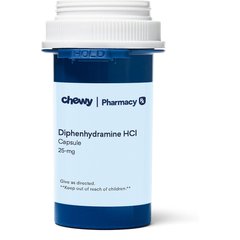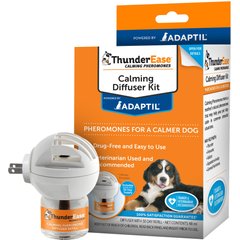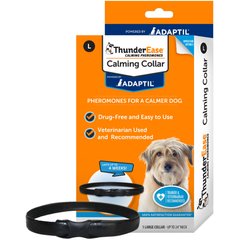Can I Give My Dog Benadryl®? And if So, How Much?
NOTE: It’s always best to contact your veterinarian for guidance before administering any medication to your pet, including Benadryl®.
Benadryl®, also known by its generic name, diphenhydramine, is one of the few over-the-counter drugs designed for people that veterinarians may have pet parents administer at home.
You might be looking at using Benadryl® for dogs to keep your pup calm, or maybe your dog was stung by an insect and is having a mild allergic reaction. But while Benadryl® is generally well tolerated by dogs and has a wide safety margin, it’s not necessarily the answer to your dog’s issue.
For some dogs, giving Benadryl® to calm them may have the opposite effect and make them more anxious. In addition, Benadryl® should not be given to animals with certain health conditions or pups taking certain medications.
So, when is Benadryl® for dogs effective and safe, and when does your dog need a different treatment? Here are a few things you should keep in mind before giving your dog Benadryl®.
Health Tools
Not sure whether to see a vet?
What Is Benadryl®?
Benadryl® is a first-generation antihistamine that prevents H-1 receptors in the body from reacting to histamine. It can also ease nausea and vomiting by inhibiting the chemoreceptor trigger zone (vomiting center) in the brain and reducing the way that the vestibular apparatus (the balance center in the ear) responds to motion.
Veterinarians most commonly recommend that pet parents give their dogs Benadryl® to prevent or treat mild allergic reactions and to reduce nausea and vomiting associated with motion sickness or vestibular disease.
Can Benadryl® Be Used for Dog Allergies?
Taken orally, Benadryl® for dogs can help ease mild allergic symptoms to common triggers such as pollen, mold, and house mites, particularly if it’s used in combination with other allergy treatments. Benadryl® can also be used for mild allergic reactions to insect bites or stings. Oral or injectable Benadryl® can be used as a pre-treatment for mild allergic vaccine reactions.
But if your pet is having an acute allergic reaction with facial swelling or difficulty breathing, take them straight to the vet. Severe allergic reactions can be life-threatening. Dogs often require aggressive supportive care and treatment with steroids and epinephrine in addition to Benadryl®.
Can Dogs Take Benadryl® for Anxiety?
You might have heard that Benadryl® can be given to dogs to help with travel anxiety or dogs that are scared of fireworks and thunderstorms, but it really isn’t very effective. Benadryl® may make some dogs a little sleepy and less responsive, but it doesn’t do anything for their underlying anxiety.
If your dog has anxiety, talk with your veterinarian to determine a course of treatment. It might involve making changes to your dog’s environment, behavioral training, prescription medications, or tools such as anxiety vests and pheromones.
Benadryl® does has some efficacy in the prevention of motion sickness in dogs. So, if your dog is anxious because they’re nauseous in the car, it could help. Some dogs and cats actually have the opposite reaction to Benadryl®, causing hyperactivity instead of sedation.
You can also consider crating your dog in the car, which sometimes helps with motion sickness.
Is Benadryl® Safe for Dogs?
By and large, Benadryl® is very well-tolerated in dogs, with few side effects and a low risk of overdose when used correctly.
But the reason why you still need to check with your veterinarian is because there are safety risks if your dog has certain health conditions or takes certain medications.
Some instances in which Benadryl® should not be used (or should be used with caution) include:
-
Cardiac conditions (cardiovascular disease)
-
Some lung conditions
-
Liver disease
-
Difficulties urinating
-
Pregnancy
-
In conjunction with certain medications, including monoamine oxidase inhibitors, and come drugs used to treat fungal infections
Side Effects of Benadryl® for Dogs
At normal doses, the most common side effects of Benadryl® exhibited by dogs include drowsiness and being unsteady on their feet. But if a dog receives too much Benadryl®, they might exhibit:
-
More pronounced sedation or agitation
-
Severe unsteadiness
-
Disorientation
-
Aggression or other unusual behaviors
-
Slow breathing
-
Vomiting
-
Diarrhea
-
Coma
-
Seizures
Call your veterinarian for advice if your dog experiences any worrisome symptoms after taking Benadryl®.
What’s the Benadryl® Dosage for Dogs?
With any medication, the safest way to know the proper dose for your dog is to ask your veterinarian. In addition, many formulations are combined with other potentially dangerous medications, such as Tylenol. Make sure your Benadryl® tablets contain only diphenhydramine.
According to the Merck Veterinary Manual, the standard dose for Benadryl® is 2–4 milligrams per kilogram of body weight, or 0.9–1.8 milligrams (mg) of Benadryl® per pound.
Therefore, a simple and practical dose is 1 mg of Benadryl® per pound of your dog’s weight, given two to three times a day. For example, a 10-pound dog might receive a 10 mg dose in the morning, afternoon, and evening.
|
Your Dog’s Weight |
Recommended Dosage |
Maximum Dosage |
|
5 pounds |
5 mg |
10 mg |
|
10 pounds |
10 mg |
20 mg |
|
20 pounds |
20 mg |
40 mg |
|
30 pounds |
30 mg |
60 mg |
|
40 |
40 mg |
80 mg |
|
50 |
50 mg |
100 mg |
|
75 |
75 mg |
150 mg |
|
100 pounds |
100 mg |
200 mg |
There are also different forms of Benadryl®, including tablets, capsules, liquids, and children’s chewable tablets, all of which can make it difficult to figure out the amount to give your dog. When in doubt, ask your vet!
Benadryl® Tablets and Capsules
Benadryl® tablets are available and contain either 25 mg or 50 mg of diphenhydramine, which would be the appropriate size for a 25-pound or 50-pound dog, respectively.
Give more than one tablet or capsule at a time to add up to the appropriate dose for larger dogs. You can split 25 mg tablets in half to fine-tune your dog’s dose. For example, one 50 mg tablet and half of a 25 mg tablet would be appropriate for a dog weighing 60 pounds.
Children’s Chewable or Liquid Benadryl® for Dogs
Children’s chewable or liquid Benadryl® are good options for tiny dogs. A full chewable children’s tablet contains only 12.5 mg of diphenhydramine and can be cut in half for dogs that weigh less than 10 pounds.
Children’s liquid Benadryl® contains only 2.5 mg/ml and may be easier to give to small dogs that resist taking pills.
How Often Can You Give Your Dog Benadryl®?
Dogs can be given Benadryl® every eight to 12 hours (two to three times a day).
Are there Alternatives to Giving a Dog Benadryl®?
Diphenhydramine has been around for a long time, and continued research has led to the development of treatments that may be more effective than Benadryl®.
-
Using several different types of treatment at the same time (medicated shampoos, supplements, and prescription medications, for example) is the best way to manage a dog’s allergies.
-
Prescription anti-anxiety medications for dogs combined with a behavioral modification program will do a much better job than Benadryl® when it comes to helping dogs with anxiety.
Talk to your veterinarian if you have any questions about giving your dog Benadryl® or other ways to keep them healthy and happy.
Featured Image: iStock.com/ILIA KALINKIN







